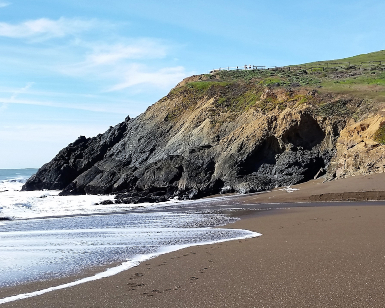San Rafael, CA – Water quality was excellent last summer at all Marin County beaches according to a new report from Heal the Bay, which annually rates water quality at beaches along the U.S. West Coast.
The summer day grades at the Marin County were exemplary for a third straight year with 100% of the beaches receiving A grades. The grades came from sampling 24 beach sites over 31 weeks.
 Water quality ratings was excellent last summer at Marin beaches, including at Rodeo Beach in the Marin Headlands.
Water quality ratings was excellent last summer at Marin beaches, including at Rodeo Beach in the Marin Headlands.Marin’s water quality monitoring program, overseen by the Marin County Community Development Agency’s Environmental Health Services Division (EHS), gathered data from April 2020 through October 2020 from 28 bayside and oceanside monitoring locations. Twenty-five are marine beaches and three are fresh water recreational sites. The beaches are managed by several agencies: Twelve federal beaches, five state beaches, seven County of Marin beaches, and four local or privately managed beaches. One intermittent creek, Chicken Ranch Ditch at Chicken Ranch Beach near Inverness, is measured when there is sufficient water level for sampling and the County added an additional monitoring site Whitehouse Pool. The sample collection at the Whitehouse Pool started August 31, 2020.
Summer dry grades were excellent across the state and slightly above average, with 95% of California beaches receiving A and B grades. Only one county in the Northern California conducted wet weather monitoring, and the other four counties in Northern California did not have wet weather grades. The five-year average of wet weather A’s and B’s is 83%. The Heal the Bay report cites lower rainfall totals than the previous year and received 43% less rainfall than the historical average of 22 inches. The full impact of the decreased rainfall in winter months is difficult to assess because majority of the beaches are not monitored during the winter months.
Rain alleviates drought conditions, but more rain means that more pollutants, including bacteria, are being flushed into the ocean. Rain flushes contaminants from streets, including trash, fertilizer, pet waste, metals, and automotive fluids, into urban waterways. The untreated runoff drains directly into the ocean and results in elevated bacteria levels. Additionally, seasonal high groundwater tables may result in septic seepage reaching waterways.
According to the report, Marin experienced four reported sewage spills that reached a body of water in the 2020-21 monitoring period, down from 20 that were reported in 2019-20 monitoring period. The Marin spills amounted to 111,525 gallons of sewage reaching surface water.
Heal the Bay, based in Santa Monica, has analyzed water quality data at California beaches each year since 1991. It also rates beaches in Oregon and Washington. The Beach Report Card is funded by grants from the Surf Industry Manufacturers Association and the Grousbeck Family Foundation. See the full report at HealtheBay.org.
Marin EHS has monitored ocean, bay and freshwater sites since 2003 and posts sample results weekly. The samples are processed by the Napa-Solano-Yolo-Marin County Public Health Lab. The tests utilized, quantify the most-probable number of Total Coliform, E. coli, and Enterococcus bacteria present in each water sample.
If lab results indicate water samples exceed State of California standards for recreational waters, a warning sign is posted to alert the public that bacterial standards were not met. The California Department of Public Health advises beach users to avoid contact with recreational waters where warning signs are posted. People in contact with elevated bacteria levels in recreational waters may become ill.
Heal the Bay recommends beach users never swim within 100 yards on either side of a flowing storm drain, creek, or river in any coastal waters during a rainstorm, and to stay out of the water for at least three days after a storm has ended.
Learn more about the local testing program on the Marin EHS webpage.